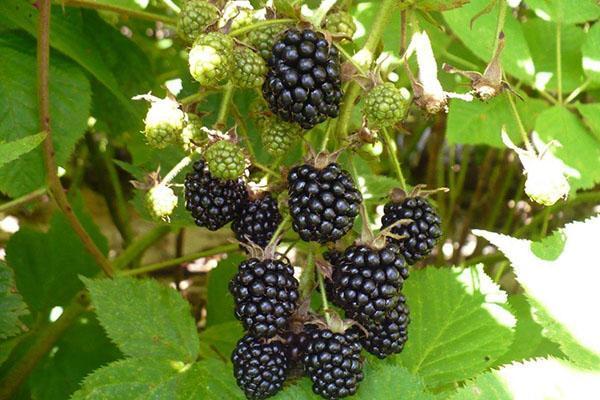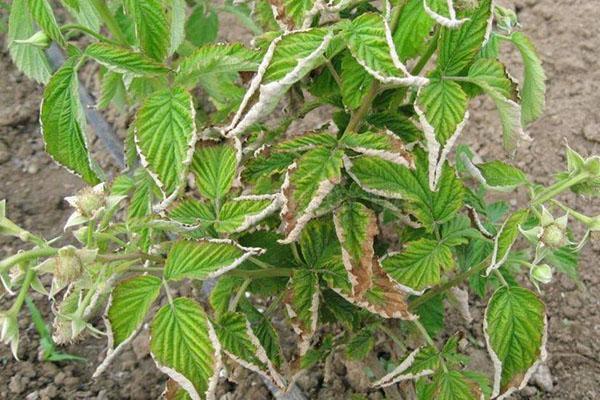How do blackberry diseases manifest and how to deal with them
 Knowing what blackberry diseases are, you can grow a beautiful and healthy plant. The berries harvested from our own plot are the tastiest. Many people prefer dark and large fruits. To achieve the desired result, it is important to recognize the problem in time, determine what exactly causes it and promptly start treating the garden culture.
Knowing what blackberry diseases are, you can grow a beautiful and healthy plant. The berries harvested from our own plot are the tastiest. Many people prefer dark and large fruits. To achieve the desired result, it is important to recognize the problem in time, determine what exactly causes it and promptly start treating the garden culture.
The main diseases of the blackberry

Yellow blackberries indicate the development of dangerous diseases, the treatment of which must be started immediately.
The most common blackberry diseases:
- rust;
- purple spot;
- anthracnose;
- septoria.
 The natural habitat of fungi is soil. They spread easily by wind and rain. The source of infestation can be untreated equipment or new seedlings. The infection quickly penetrates through damage to any part of the plant during transplantation. Diseases are spread by insects that live on blackberries and lack of minerals or vitamins.
The natural habitat of fungi is soil. They spread easily by wind and rain. The source of infestation can be untreated equipment or new seedlings. The infection quickly penetrates through damage to any part of the plant during transplantation. Diseases are spread by insects that live on blackberries and lack of minerals or vitamins.
To find out why blackberries are drying, you should carefully examine the leaves. The color change will tell you which vitamin is missing.
 The list of substances and signs of their deficiency in a plant:
The list of substances and signs of their deficiency in a plant:
- Iron. Lack of the element is the first reason why blackberries dry out. The leaves turn yellow and the veins turn pale.
- Nitrogen... All parts of the plant are weaker: the leaves become smaller, become yellowish and brittle, blackberries do not bloom well, bears fruit with small berries.
- Potassium. The formed plates have a brown border, the berries when ripe become very soft in the middle. Often, yellow leaves on blackberries are seen in spring.
- Calcium. The upper buds, without blooming, die off, the young foliage turns yellow.
- Magnesium. The leaf plates acquire an uncharacteristic shade - red or purple, transparent areas are visible on them, the plant discards them early.
- Phosphorus. Leaves bloom with a delay, quickly darken, turn black and dry out.
- Copper. The shoots do not want to grow, the tops of the bush disappear, the edge of the leaf turns white.
- Bor. Small, deformed and twisted leaves, which quickly fall off, cork depressions form in the berries.
- Zinc. Thickened and small leaves at the tops of the bushes.
- Manganese. Patterns appear on the leaves, the plates turn yellow and fall off.
- Molybdenum. Light spots on new leaves that dry and curl quickly.
In addition, various viruses infect blackberries. They cause yellow netting, curling, or mosaic. The affected bushes do not respond to treatment. They must be destroyed so that the virus does not spread throughout the site and does not infect other crops.
Anthracnose is a disease that destroys culture
 This is a common blackberry disease that takes effort to combat. The disease is provoked by the mushroom Gloeosporium venetum Speg. It infects plants in late spring or early summer. Frequent rains, too zealous watering contribute to this.
This is a common blackberry disease that takes effort to combat. The disease is provoked by the mushroom Gloeosporium venetum Speg. It infects plants in late spring or early summer. Frequent rains, too zealous watering contribute to this.  This fungus thrives in cool, humid regions. For example, in the northern part of Belarus, Russia and Ukraine. The infection affects all parts of the plant above the ground.
This fungus thrives in cool, humid regions. For example, in the northern part of Belarus, Russia and Ukraine. The infection affects all parts of the plant above the ground.
The disease can be identified by gray sores. The berries of such a blackberry slowly ripen and gradually dry out.More often, even in a green state, they bend and fall off.
Castings, when affected by a fungus, become smaller, become covered with spots (gray or with a purple outline). Then lunges form at the site of the blotches, it seems that insects have settled on the plant. The spots are usually located near large veins and along the edges of the plates.
Blackberry shoots are rarely affected by anthracnose. On the root suckers, oblong spots of a violet hue are formed, which crack in the center. Later they "grow", penetrate deep into the depths. The purple outline remains, and the middle color changes to gray. The bark on the shoots exfoliates. Fruit branches, as if surrounded by rings, begin to dry out along with green berries.
 To get rid of anthracnose, you need to use the following measures:
To get rid of anthracnose, you need to use the following measures:
- in early spring or autumn, fertilize the site with manure or a mixture of peat;
- when forming berries, feed them with mineral complexes;
- site cleaning, thinning;
- the control glaze;
- removal of all damaged parts of the bush after wintering.
 If the spread of the infection could not be avoided and its first signs appeared, then treatment with fungicides should be carried out. Each of them has instructions that it is important to adhere to.
If the spread of the infection could not be avoided and its first signs appeared, then treatment with fungicides should be carried out. Each of them has instructions that it is important to adhere to.
Typically, the affected blackberry is treated three times. First, before flowering, then - when new shoots reach a height of 35 cm, the third time - after harvesting. Good results are obtained by treating the soil around the plants before wintering, as well as after it, with the simultaneous removal of diseased branches.
From drugs to combat anthracnose, a 5% solution of iron or copper sulfate, Fundazol, Fundazim, Topaz, Cuproxat, BardoBlyu are suitable.
Purple spot
 This insidious disease is also called didimella. Its danger is that it is almost invisible on large leaves. The disease primarily affects the kidneys, young shoots, petioles.
This insidious disease is also called didimella. Its danger is that it is almost invisible on large leaves. The disease primarily affects the kidneys, young shoots, petioles.
Infection begins to manifest itself through drying and dying off of the buds, drying out of shoots, falling foliage. Purple spots with a brown tint appear on the stem of the blackberry, they gradually "grow". They infect areas near the petioles, which also turn purple.
 Leaves cover dark spots with yellow outlines. Whole branches can turn gray-purple. They shed their leaves, melt brittle, dry out. Diseased blackberries bloom poorly, bears fruit with small berries with coarse bones. It is the presence of this disease that answers the question: "Why are blackberries sour?"
Leaves cover dark spots with yellow outlines. Whole branches can turn gray-purple. They shed their leaves, melt brittle, dry out. Diseased blackberries bloom poorly, bears fruit with small berries with coarse bones. It is the presence of this disease that answers the question: "Why are blackberries sour?"
To eliminate purple spotting:
- At the beginning of spring, the bushes are sprayed with bard liquid (2%).
- In case of severe damage, the fungicides Fundazol and Topsin M.
- Provide cleanliness on the site, thinning plantings, spring cleaning is especially important.
- In extreme cases, the blackberry bushes are destroyed, the soil is disinfected, and the new material is planted in a part of the garden remote from the previous berry.
If you want the plant to produce a bountiful harvest, you should constantly inspect the bushes. In the event that yellow leaves appear on a blackberry, it is necessary to apply efforts as soon as possible, because this is the first sign of serious illness.
Autumn processing of blackberries - video